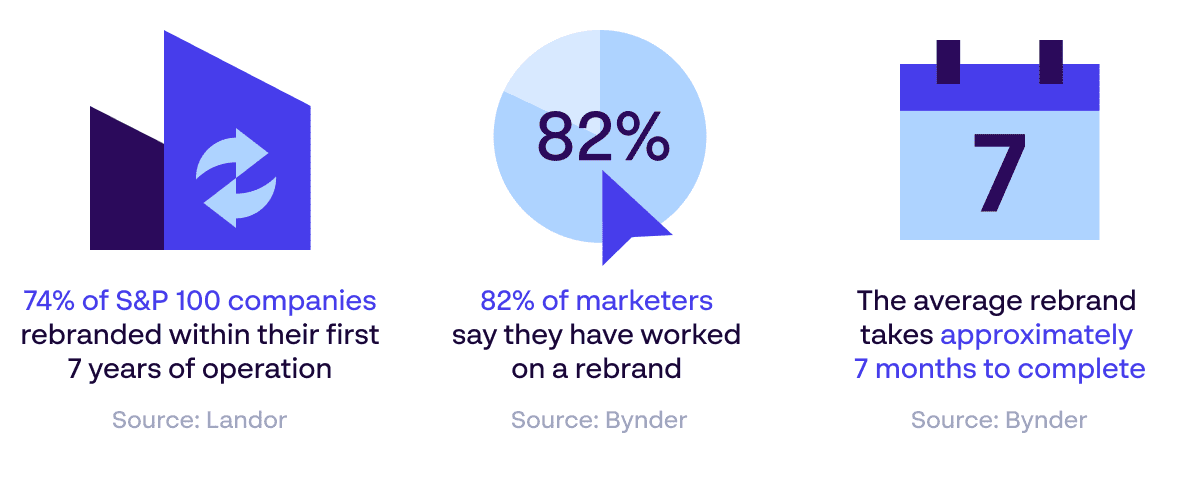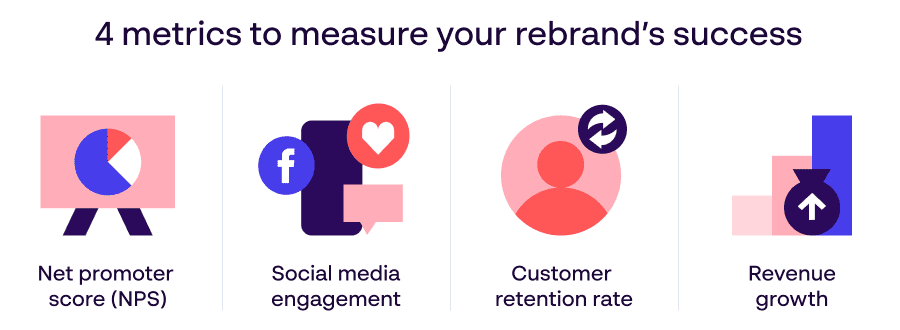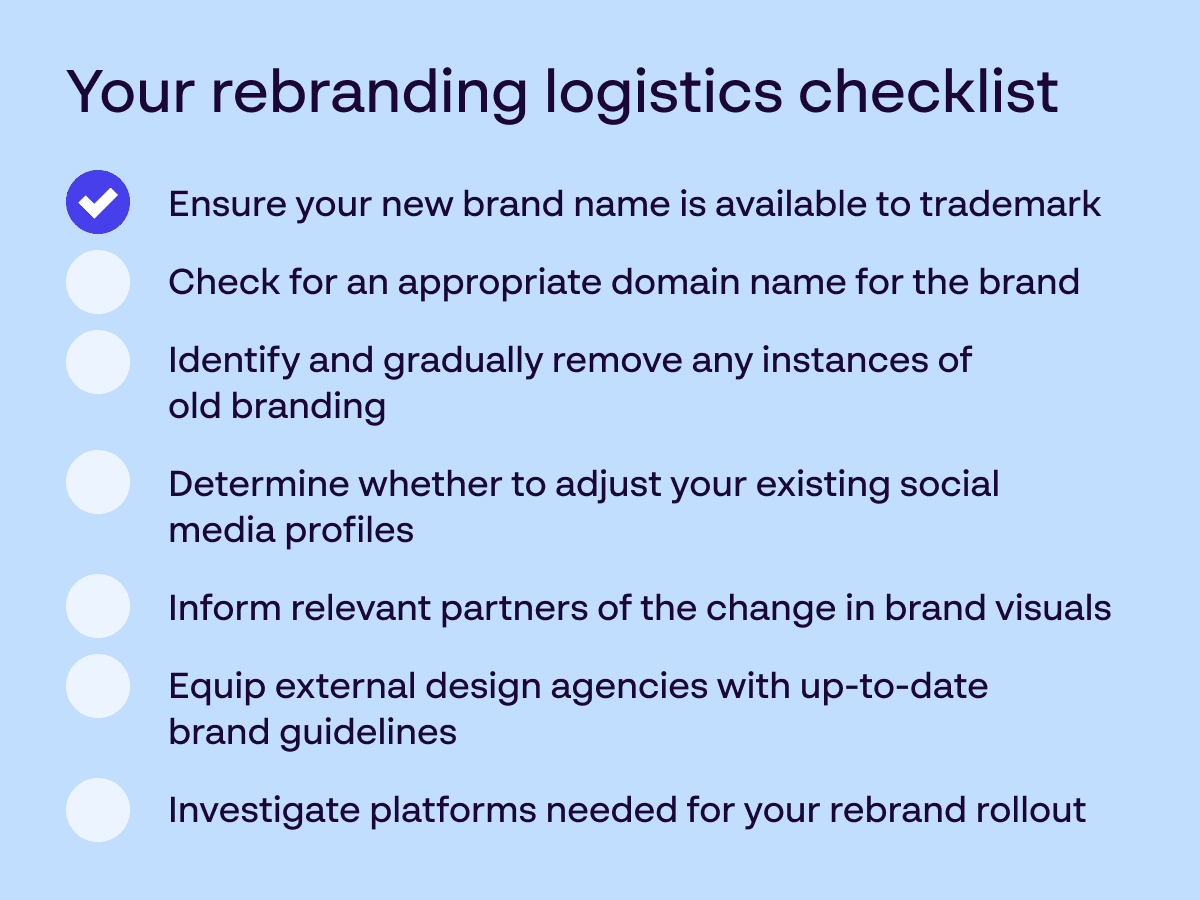By agreeing on what KPIs your team will track before pulling the trigger on your new brand, you can ensure you receive feedback from the start, so you can make improvements depending on what your data is telling you.
A rebrand is a pivotal step in any organisation’s journey – one that can breathe new life into your business when done successfully.
While it can feel daunting from the outset, keep in mind that 74% of S&P 100 companies underwent a rebrand in their first 7 years of existence. Microsoft’s well-known multicoloured window logo is the company’s fifth since its formation in 1975, each change representing a shift in brand strategy and visual identity.
So why do companies do it? A rebrand offers an opportunity to reshape their brand messaging for an up-to-date target audience. To break into new markets, refocus their marketing efforts and enhance their bottom line. For recognisable names like Burberry, Old Spice and Lego, a well-structured rebrand revitalised their image.
However, even when a rebrand is the right call, numerous challenges can cause irreversible damage to your brand equity and harm relationships with your customers. It’s a big leap, and never one to be taken lightly.
If your brand is considering a big change, or if you’re already deep in the rebrand implementation process, this ultimate guide outlines the 7 standout challenges you must overcome and gives you the solutions for smooth, successful brand management:
- Rebranding for the wrong reasons
- Securing customer buy-in
- Mapping out your rebrand’s scale
- Internally communicating your rebrand
- Measuring your success
- Locking down logistics
- Handling the brand relaunch

Challenge #1: Rebranding for the wrong reasons
Your brand identity goes beyond the design of your logo or your colour palette – it’s the essence of your emotional connection between you and your customers, employees and the wider world. It’s your company vision, it’s your personality, it’s how people understand YOU.
Brand recognition shouldn’t be toyed with – it takes years of effort to build and can disappear in an instant. That’s why the vast majority of successful rebrands overcome the first hurdle: identifying a legitimate need to update their image.
Take Old Spice as an example. When its name had become intrinsically linked to the older gentleman, it restricted their ability to engage with younger audiences and made them appear “uncool”. Their 2010 rebrand with the memorable “The Man Your Man Could Smell Like” campaign addressed this stagnation and brought their brand into the modern day.
On the other side, you have American retailer GAP. After a short, sudden decline in sales, they invested an estimated $100 million on rebranding their iconic blue logo into one that was more high-brow. This went against the values of convenience and low prices customers expected from GAP, meaning the change was immediately rejected and abandoned.
These competing examples demonstrate the importance of rebranding for the right reasons:

To make sure a complete rebranding campaign is the right step forward, as opposed to a less comprehensive refresh, engage in objective conversations with your shareholders, employees, customers and beyond. Active stakeholder engagement is essential early on to approach this question with a clear, open mind, enabling you to determine whether a rebrand offers more promise than problems.
Moreover, a comprehensive brand audit can identify the strengths and weaknesses of your current branding, empowering you with insight to either justify the importance of a rebrand or bring you back from the brink of a costly, fruitless endeavour.

Challenge #2: Securing buy-in from customers
One of the biggest challenges for any rebranding strategy is getting customers on board with your new changes.
When it takes between 5 and 7 impressions for a customer to recall a brand from memory, getting them to forget this and embrace new visual elements and communications can be a tall order.
This is where GAP’s rebrand fell apart and why Tropicana lost $30 million after changing the beloved packaging of their orange cartons in 2009. They failed to talk to their customers and prepare them for the transition, meaning their rebrand fell flat, losing face in their target markets.

How you overcome customer perceptions and facilitate this transition to your new brand identity will play a key role in the success of your rebrand.
Overcoming this challenge starts by conducting thorough market research and surveys to sense how current and prospective customers view your brand. This can provide solid, tangible feedback on what people want to see from a revamped version of your business.
Furthermore, carrying over older brand elements into this new vision can ease the transition for customers and maintain familiarity. Especially for strong brands, this staggered approach can help preserve loyalty while you simultaneously target new audiences.

Challenge #3: Mapping the scale of your rebrand
Particularly for globally recognised brands with a presence on multiple marketing channels, the scale of a rebrand can be daunting. Approaching it without a full grasp of what’s required can add innumerable costs and delays to the process.
Moreover, a disorganised approach could mean smaller visual elements, such as letterheads or email signatures, are overlooked. This can lead to outdated graphics, logos or imagery remaining in circulation in your marketing, sowing confusion, raising distrust and harming your brand consistency.
The solution? Granularly map out every facet of your brand and your broadcast channels. Engage your marketing teams to ensure no stone is unturned during this transition, and collate everything identified into one unified, shared document.

Once your transition plan is complete and executed, utilise a Digital Asset Management (DAM) platform to contain all refreshed brand imagery and collateral. This technology will give everyone in your organisation access to the latest resources, while simultaneously allowing you to lock away any remnants of the old branding so it can never accidentally find its way out.
Challenge #4: Internally communicating your rebrand
While your rebrand might be aimed towards your customers, it’s also necessary that your team members are on board.
After all, the people at the heart of your business are responsible for carrying your new marketing materials, voice and values to your target audiences. If they’re unaware or unsure about the new brand, this could affect how they communicate it. Long-term employees may default to the old regime, confusing your brand alignment.
When you consider that 92% of consumers trust word of mouth over any other form of branded promotion, you see how important it is to get everyone connected to your business speaking the same language when it comes to your rebrand.

For international organisations, this is even more pressing. Without a firm communication strategy across your locations, the implementation of your rebrand can be incredibly slow, convoluted and inconsistent. Your branding on one side of the world could be completely different on the other – in an increasingly connected planet, that will be picked up on quickly.
How do you address this problem? Setting up a dedicated brand hub at the centre of your rebrand can help ensure it’s understood and applied universally. Within this digital resource, any team member can be educated on brand guidelines, exemplar assets and more to give them complete clarity over how your brand should now be presented.
This single source of truth, reinforced by wider brand management solutions, will go a long way in keeping your teams aligned and educated on your current brand identity. Rather than an uncoordinated, haphazard approach, this centralised, structured method can make the adjustment period for your employees much simpler.

Challenge #5: Quantifying the success of your rebrand
While rebrands can help companies appeal to new audiences, reposition their place in the market and address negative brand perceptions – success isn’t a foregone conclusion.
Before breaking ground on your rebrand, you should determine what a successful outcome will look like when you go live. While there’s sure to be plenty of anecdotal evidence to suggest whether your rebrand has been well received or not, data is the definitive marker for success.
So, what metrics should you keep in mind once your materials are out in the world? The simple answer is it depends. Different companies will commission a rebrand for different reasons; some might want to reach new audiences, while others aim to accommodate the launch of a new product.
Whatever metrics are most appropriate to track, make sure you’re assessing everything from a financial perspective. These projects eat up a significant chunk of your marketing budget, so higher-ups will want to know whether these adjustments delivered a return on investment.

Challenge #6: Locking down the logistics of your rebrand
It’s easy to get lost in the logistical demands of a rebrand. For instance, if your brand name changes, is this available as a trademark? Have your new designs and visuals been communicated to your packaging partners or external agencies?
These hurdles, be they legal formalities or gaps in your asset creation processes, can do more than delay your rebrand – they can place your organisation at risk of liability breaches and fracture relationships with your partners.
To ensure the logistical side of your rebrand is completed in full, use this checklist to stay on track:

Beyond this, your style guides, website imagery, social media assets, letterheads and more will need to be reworked. Many organisations will outsource this to an external agency, but this can be expensive, potentially resulting in partners failing to treat your branding and assets with the same attention to detail you would.
To take a more cost-conscious, in-house approach, building and using intelligent design templates can make it straightforward to execute your brand refresh. With an effective, intuitive solution, anyone in your team can play an active role in creating studio-quality assets for any channel, so you are fully prepared with collateral for the launch of your new identity.
Challenge #7: The all-important brand relaunch
All that’s left now is to launch your rebrand. But with competition for your customers’ attention and loyalty fiercer than ever, revealing your new identity involves more than just a flick of a switch.
To maximise the chances that your new direction is met with intrigue and excitement instead of concern or confusion, it’s hard to overstate the importance of a well-coordinated rebrand rollout campaign.
Get everything ready for the big day by creating a need-to-know sequence, so your team can roll your rebrand out to each audience in order of importance, from employees and customers right the way through to your suppliers and the media. Facilitating this with campaign execution tools can add a tangible structure that keeps your work on track.
Next, establish a narrative behind your new identity. You want to make it as clear to your audience why you have taken this step, and how it will specifically benefit them.

Then, devote time to forecasting (or hyping up) your new rebrand. Audiences are generally resistant to change at the best of times, and hitting them with a top-to-bottom rebrand out of nowhere is likely to stoke confusion, frustration and negativity. Creating a gradual build-up with teases of the new image allows them to adapt to the change over time.
Finally, create a communication strategy for the initial days, weeks and months after launch to reinforce your new brand in your customers’ minds. This can quickly breed familiarity and eventually distance your audience from your former identity.
Unlock the full potential of your next rebrand
For many companies, rebranding has been the key to their ongoing success. They enable organisations to appeal to new customers, tap into fresh markets, and build recognition among key audiences.
But creating a new identity for your brand is no easy feat. We hope this guide has enabled you to better understand whether rebranding is the right decision for you, and overcome the multitude of challenges that can derail the debut of your new image so you can make this investment a genuine success.

Table of contents:
- Challenge #1: Rebranding for the wrong reasons
- Challenge #2: Securing buy-in from customers
- Challenge #3: Mapping the scale of your rebrand
- Challenge #4: Internally communicating your rebrand
- Challenge #5: Quantifying the success of your rebrand
- Challenge #6: Locking down the logistics of your rebrand
- Challenge #7: The all-important brand relaunch
- Unlock the full potential of your next rebrand
